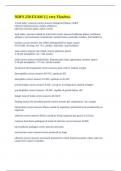NDFS 250 EXAM 2 || very Flawless.
3 food safety concerns correct answers biological (illness, GMO)
chemical (natural toxins, metals, additives)
physical concerns (glass, metal, wood)
food safety concerns ranked by actual risk correct answers foodborne illness, nutritional
adequacy, environmental contaminants, natural toxins, pesticides residues, food additives
bacteria correct answers one celled, distinguished by shape, spores
4.6-9.0 pH, all temp, Aw >9.1, aerobic, anaerobic, and facultative
yeast correct answers one celled, oval or spherical, spores
2-10 pH, mesophiles, Aw >.88, aerobic
mold correct answers multicellular, filaments give fuzzy appearance, aerobes, spores
2-10 pH, mesophiles, >.75 Aw, strictly aerobic
facultative microorganisms correct answers grow with or without oxygen
thermophiles correct answers 40-70 C, optimum 45C
mesophiles correct answers 10-50C, optimum at 20-45C
psychrotrophs correct answers 0-30C, can grow at refrigerated, optimal at higher
psychrophiles correct answers -10-20C, capable of growth below 10C
danger zone of foods correct answers 40-140 F
limiting factors for microbial growth correct answers pH, temperature, Aw, oxygen
intoxication correct answers illness caused by ingesting a preformed toxin produced by an
organism
infection correct answers illness caused by living organism that grows in GI tract
common food borne pathogens & mode of infection correct answers SLIDE
top foodborne pathogen correct answers norovirus
mycotoxins correct answers toxins produced by fungi
aflatoxin correct answers mycotoxin produced by mold, found in peanuts, wheat, and corn
causes liver cancer in animals
,fightbac correct answers clean, separate, cook, chill
USDA thawing correct answers 1. in the fridge
2. in cold tap water (change every 30 minutes)
3. in microwave (cook immediately)
4. cook without thawing (50% longer)
hazard analysis and critical control point (HACCP) system of food protection correct answers
assess hazards, id CCPs, set up control procedures and standards for CCPs, monitor CCPs, take
corrective action, develop a record-keeping system, verify the system is working
*prevention
food safety labeling correct answers best if used by, expiration date, pack date, pull date,
allergens statement
responsibility for food safety correct answers food producers, food manufacturing and processing
companies, food service establishments, consumers, government agencies
useful purposes for mold correct answers soy sauce, blue cheese
useful purposes for yeast correct answers bread, beer, wine, vinegar
useful purposes for bacteria correct answers yogurt, buttermilk, swiss cheese, fermented pickles,
sauerkraut, vinegar
what attributes are preserved during food preservation correct answers sensory, nutrition, safety
basic causes of food deterioration correct answers biological: microorganisms, infestation
chemical: nonenzymatic, enzymatic
physical/environmental: temperature, moisture, oxygen, light, stress/abuse, time
water preservation treatments correct answers drying/dehydrating
solute addition
temperature preservation treatments correct answers thermal processing
refrigeration, freezing
other preservation processing treatments correct answers irradiation, high pressure, ohmic
heating
oxygen preservation treatments correct answers vacuum or inert atmosphere packaging
chemical preservation treatments correct answers antimicrobials, antioxidants, acidifiers
aseptic conditions correct answers packaging, processing in sterile conditions
, nutritional value of foods after processing correct answers freezing keeps it the most, canning,
refrigerating, field
reasons to preserve food correct answers availability, variety, quality, connivence, cost
factors to consider when preserving food at home correct answers cost, space, quality, use it?,
self reliant
drying correct answers removal of water from a food using ambient conditions
dehydration correct answers removal of water from a food using controlled conditions of heating,
forced air circulation, and relative humidity
sun-drying correct answers no specific controls, causes largest loss of nutrients of any drying
method b/c of light sensitive molecules
grapes, plums, figs, apricot, pears, peaches, grains
solar drying correct answers sun's rays heat air under plexiglass
heated air rises through food on drying racks, removing moisture
spray drying correct answers spraying liquid into a current of dry, heated air
freeze-drying/lyophilization correct answers product is frozen, then heated in a vacuum chamber
ice converts directly to water vapor (sublimation)
expensive but preserves quality and texture
drum drying correct answers product is made into a slurry and spread on the surface of a rotating
drum heated inside by steam; when dried, product is scraped off/vacuum
more economical but lower quality than spray drying
tunnel drying correct answers Dry air is blown cross-current or counter-current at a high velocity
around the food; the dry air provides heat and takes away the water
extrusion drying correct answers slurry of cereal flour is passed through heated tube under
pressure. as product exits through a sized opening, sudden pressure release causes water to
evaporate
puffs, pastas
other processes that dry food correct answers deep fat frying, baking, osmotic dehydration
optimizing storage of dehydrated foods correct answers humidity, air, light, temperature
purposes of thermal processing correct answers To make food safe
To extend shelf life
To improve palatability




